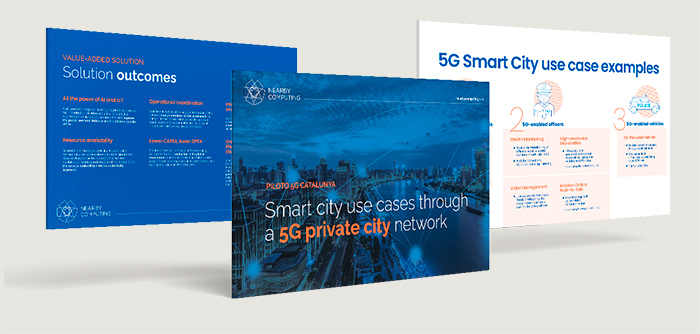PILOTO 5G CATALUNYA
Smart city use cases through a 5G private city network
The challenges ahead
01
IMPROVE PUBLIC SERVICES
After deploying FO and Wi-Fi networks in the past, cities want to understand how 5G technologies can improve public services.
02
REAL TIME
DECISIONS
As cities generate massive amounts of data, solutions based on AI and IoT can bring more accurate information and help city managers to take better decisions, including real-time ones.
03
DISTRIBUTED
INFRASTRUCTURE
Managing computing infrastructure distributed across the city presents new and complex requirements compared to current centralized computing in datacenters.
Solution architecture
5G Smart City use case examples
analysis of vehicle traffic
Vehicle counting.
Event detection: vehicle stopped on tramway crossing zone.
Bicycle counting on bike lanes.
Real-time Monitoring of officers’ vitals
via wrist sensors (heart-rate, etc).
Activity detection: stopped, walking, running.
Geolocation
Ultra accurate geolocation (<1m) of every officer using the cellphone GPS data. (Leveraging Albora Technologies)
Live access to the video feeds emitted by the body –worn cameras carried by every officer.
Push-to-Talk
1:1 and group call voice/video communication.
(Leveraging Nemergent solutions)
through orchestrator.
Deployment of virtualized
dispatching apps, LPR, etc.
IT infra LCM OTA.
VALUE-ADDED solution
Solution outcomes
All the power of AI and IoT
A 5G-powered edge computing city platform allows a fast introduction of video analytics, IoT analytics, augmented reality etc applications that can improve the public services’ delivery and the citizens’ quality of life.
Lower CAPEX, lower OPEX
Greater efficiencies in the use of the computing equipment lead to a reduction in the global investments. Automation and orchestration avoids most of the human-led operations and of errors, thus leading to a relevant OPEX reduction.
Information generated
and consumed everywhere
Any node in the network can generate, process or consume information, leading to a global enhanced city resilience and capacity of dealing with potential situations.
Operational coordination
As information flows from any part to any part of the network, many operations can be automated and human intervention is instantly coordinated. As a result, less errors are commited and no relevant information is left without being processed.
Orchestration allows a full lifecycle management of the distributed infrastructure
A central or several federated orchestrators take care of the distributed edge computing infrastructure lifecycle Management. Provisioning, upgrades, application deployment, data processing workloads… are centrally planned and executed locally at the Edge nodes, in a fully unattended procedure. Accordingly, managing centralized or distributed infrastructure becomes fully transparent for the IT systems teams.
Resource availability
All nodes are managed centrally thus reducing dramatically the service downtime for maintenance. Also, workloads can be placed to the neariest available computing node in case of overcapacity, so the service availability time is substantially improved.

PILOTO 5G CATALUNYA
Smart city use cases through a 5G private city network




